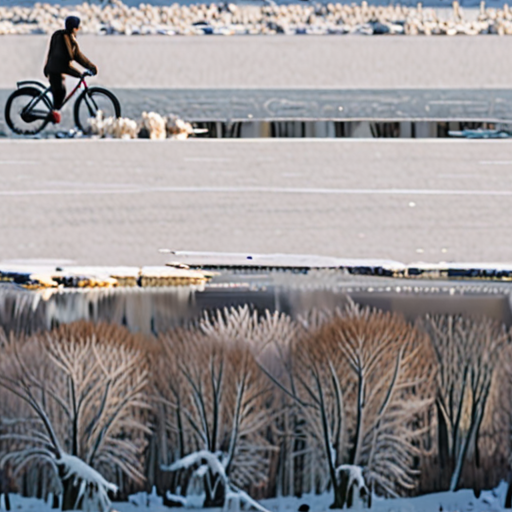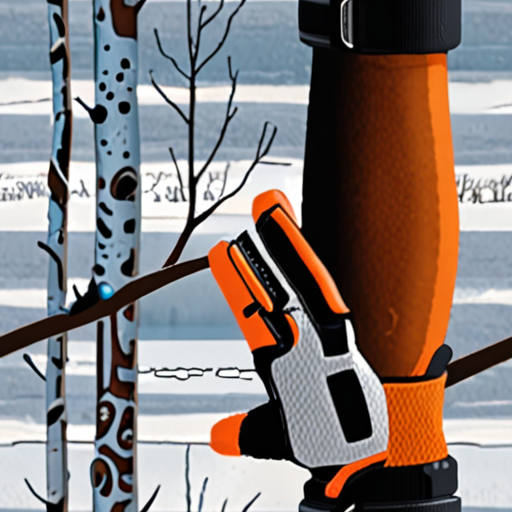If you’re contemplating taking your cycling adventures into the cold and chilly realms of winter, you’re not alone. Many cyclists wonder: how cold is too cold to ride a bike? Can you cycle in 40-degree weather? These are valid concerns given the complexities of winter cycling, such as the infamous 75 rule in cycling and the necessity of specific winter biking gear. This article will guide you through preparing for winter cycling, highlight the benefits, and provide essential tips for beginners. From understanding how to dress for colder temperatures to choosing the best winter cycling gear, including top-tier winter bike tires and cycling winter clothing, you’ll be well-equipped for those brisk adventures. Along the way, you’ll learn about protecting your lungs while biking in cold weather and engage with valuable insights from the cycling community on platforms like Reddit. Dive into the world of winter cycling and discover how to stay safe and enjoyably ride through the colder months, while mastering the art of cycling in whatever weather comes your way.

How Cold is Too Cold to Ride a Bike?
Riding a bike in cold weather can be invigorating, but there’s a point where the chill becomes unbearable.
- Personal Comfort Level: The ideal temperature for riding depends on individual comfort levels, clothing choices, and personal preferences.
- Clothing and Gear: Wearing layers, gloves, hats, and warm socks can significantly extend the temperature range for safe riding.
- Wind Chill Factor: Wind speed and direction play a crucial role in determining the perceived temperature, making it essential to consider wind chill when assessing rideability.
Temperature Guidelines for Riding a Bike
- Below 40°F (4°C): At this temperature, riders may start to feel uncomfortable due to the cold air penetrating their clothing.
- Between 32°F (0°C) and 40°F (4°C): Riders may need to wear additional layers, such as insulated jackets or pants, to stay warm.
- Below 25°F (-4°C): In extremely cold conditions, riders may struggle to maintain circulation, increasing the risk of frostbite and hypothermia.
- Below 15°F (-9°C): At this temperature, most riders will find it challenging to ride safely, and it’s recommended to postpone rides until warmer conditions return.
Factors Affecting Rideability in Cold Weather
- Humidity: High humidity can make the air feel colder than it actually is, reducing the effective temperature range for safe riding.
- Sun Exposure: Direct sunlight can warm the rider, but it’s essential to balance sun exposure with the potential for increased UV radiation.
- Physical Condition: Riders with certain medical conditions or physical limitations may need to adjust their temperature tolerance accordingly.
Staying Safe While Riding in Cold Weather
- Dress in Layers: Wear breathable base layers, insulating mid-layers, and waterproof outerwear to regulate body temperature.
- Choose Appropriate Gear: Select tires with good traction, wear gloves and hats, and consider using hand and foot warmers for added warmth.
- Monitor Weather Conditions: Keep an eye on forecasts and adjust plans accordingly to minimize exposure to extreme cold.
Conclusion is Not Required
Is it Good to Cycle in the Cold?
Cycling in the cold can have both positive and negative effects on your body.
- Burning Calories:
- Increased Energy Expenditure:
You burn more calories when cycling in the cold because your body needs to work harder to stay warm.
Cold weather cycling requires more energy expenditure due to the increased effort needed to maintain body temperature.
Benefits of Cycling in the Cold
Cycling in the cold has several benefits, including:
- Improved Mental Toughness:
- Increased Caloric Burn:
- Preparation for Extreme Weather Conditions:
Cycling in harsh weather conditions can help build mental toughness and discipline.
Cycling in the cold burns more calories than cycling in warmer temperatures.
Cycling in the cold helps prepare you for extreme weather conditions, making you a more resilient cyclist.
Risks Associated with Cycling in the Cold
Cycling in the cold also poses several risks, including:
- Hypothermia:
- Frostbite:
- Reduced Visibility:
Prolonged exposure to cold temperatures can lead to hypothermia, a potentially life-threatening condition.
Cycling in extremely cold temperatures increases the risk of frostbite, particularly on exposed skin areas.
Cold weather can reduce visibility, increasing the risk of accidents and collisions.
Precautions to Take When Cycling in the Cold
To minimize the risks associated with cycling in the cold, take the following precautions:
- Dress Appropriately:
- Stay Hydrated:
- Monitor Body Temperature:
Wear layers of breathable clothing to maintain body heat and prevent moisture buildup.
Drink plenty of water before, during, and after cycling to prevent dehydration.
Regularly check your body temperature to prevent hypothermia and frostbite.
Conclusion is Not Required

The 75 Rule in Cycling
In order to increase your cycling wattage, it’s best to follow the 75 percent rule, which states that throughout the week, 75 percent of your cycle training should be done below 75 percent of your maximum heart rate (MHR).
- This training principle helps to improve cardiovascular fitness and increase endurance.
- By incorporating interval training into your routine, you can boost your power output and efficiency on the bike.
- For example, you could spend 75 percent of your ride at a moderate intensity, with the remaining 25 percent dedicated to high-intensity intervals.
When implementing the 75 rule, consider the following:
- Warm-up and cool-down periods should be included in your ride to prevent injury and promote recovery.
- Aim to incorporate strength training exercises two to three times per week to complement your cycling routine.
- Make sure to listen to your body and adjust your training plan accordingly – rest days are essential for allowing your muscles to recover.
At Leeds Bicycle, we recommend consulting with a qualified coach or trainer to develop a personalized training plan tailored to your needs and goals.
Additionally, consider investing in a heart rate monitor or power meter to track your progress and optimize your training.
Remember to stay hydrated and fuel your body with a balanced diet to support your training regimen.
By following the 75 rule and incorporating these tips into your cycling routine, you’ll be well on your way to increasing your wattage and achieving your fitness goals.

Can You Bike in 40 Degree Weather?
Biking in 40-degree weather can be challenging, but with the right gear and preparation, you can stay comfortable and enjoy your ride.
-
Layering Up
Wearing layers is essential for regulating body temperature. Start with a breathable base layer, followed by a fleece jacket or sweater, and finally a waterproof and windproof outer layer.
Consider investing in a high-quality insulated jacket, such as the Patagonia Worn Wear Hydration Jacket , which provides excellent insulation and breathability.
-
Accessories
In addition to layering, consider wearing accessories that can help retain body heat. A pair of thermal gloves, such as the MTN Thermal Gloves , can keep your hands warm and dry.
A neck gaiter or face mask can also help protect your face and neck from wind and cold air. Look for one made from a moisture-wicking material, such as merino wool or synthetic fabrics.
-
Clothing Choices
When choosing your riding clothes, opt for items that are designed to keep you warm and dry. Consider wearing a pair of insulated pants, such as the Columbia Insulated Pants .
A pair of warm socks, such as those made from merino wool, can also help keep your feet dry and comfortable.
-
Riding Techniques
To stay safe and comfortable while biking in 40-degree weather, consider adjusting your riding technique. Ride at a slower pace, and avoid sudden movements that can cause you to lose balance.
Also, be mindful of road conditions and potential hazards, such as black ice or potholes.
By following these tips and dressing appropriately for the weather, you can enjoy a safe and comfortable bike ride in 40-degree weather.
What Temperature Should You Not Ride a Bike At?
Cycling can be enjoyed year-round, but there are certain temperatures that make it unsafe or uncomfortable to ride.
- Risk of Hypothermia
- Wind Chill Factor
- Wet Clothing
- Risk of Frostbite
- Exposure Time
- Moisture
- Recommended Riding Temperatures
- 40°F (4°C)
- 25°F (-4°C)
Hypothermia occurs when your body loses heat faster than it can produce it, causing your core temperature to drop below 95°F (35°C). Prolonged exposure to cold temperatures increases the risk of hypothermia.
The wind chill factor plays a significant role in determining the perceived temperature. A strong headwind can make the air feel colder than the actual temperature, increasing the risk of hypothermia.
Wearing wet clothing can accelerate heat loss, making it essential to dress in layers and wear waterproof gear during cold weather rides.
Frostbite occurs when skin and underlying tissues freeze due to prolonged exposure to cold temperatures. Common areas affected by frostbite include fingers, toes, ears, and nose.
The longer you’re exposed to cold temperatures, the greater the risk of frostbite. Take regular breaks to warm up indoors or in a sheltered area.
Moisture on your skin can increase the risk of frostbite. Wear gloves, hats, and scarves to protect yourself from the elements.
The ideal riding temperature varies depending on individual tolerance and the type of cycling. Generally, it’s recommended to avoid riding in temperatures below:
This temperature is considered the threshold for most casual riders. Below this temperature, the risk of hypothermia and frostbite increases significantly.
For experienced riders, temperatures below 25°F (-4°C) can still be manageable with proper gear and precautions. However, it’s crucial to monitor your body’s response and take necessary actions to prevent hypothermia and frostbite.
When riding in cold temperatures, prioritize your safety and comfort by dressing appropriately, taking regular breaks, and monitoring your body’s response. Stay informed about local weather conditions and adjust your riding plans accordingly.

Is 40 Degrees Too Cold to Ride?
Riding a motorcycle can be enjoyable regardless of the temperature, but there are certain limits to what is considered safe.
- Dressing properly is crucial when riding in cooler temperatures.
- Avoid riding in snowy conditions due to low visibility and slippery roads.
When considering whether 40 degrees is too cold to ride, it ultimately depends on various factors such as wind chill, road conditions, and personal comfort level.
- Wind Chill: A strong headwind can significantly lower the effective temperature, making it feel colder than the actual temperature.
- Road Conditions: Wet or icy roads increase the risk of accidents, making it essential to exercise caution.
- Personal Comfort Level: Some riders may find 40 degrees uncomfortable, while others may not notice a significant difference.
At Leeds Bicycle, we recommend dressing warmly and staying alert when riding in cooler temperatures.
For optimal safety, consider the following tips:
- Wear layers to adjust to changing temperatures.
- Choose breathable clothing to prevent overheating.
- Use gloves and a face mask to protect extremities from wind and cold.
Ultimately, it’s up to individual riders to decide what temperature feels comfortable for them.
Conclusion:
Riding a motorcycle in 40-degree weather can be done safely with proper preparation and caution.
By dressing warmly, staying alert, and considering road conditions, riders can enjoy their motorcycles year-round.

0 Comments